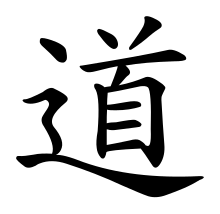Wuji (philosophy)
Wújí (simplified Chinese: 无极; traditional Chinese: 無極; literally "without ridgepole") originally meant "ultimate" but came to mean the "primordial universe" prior to the Taiji 太極 "Supreme Ultimate" in Song Dynasty (960–1279 CE) Neo-Confucianist cosmology. Wuji is also a proper noun in Modern Standard Chinese usage; for instance, Wuji County in Hebei.
| Part of a series on |
| Taoism |
|---|
 |
|
Practices
|
|
Deities |
|
Organisations |
| Classical elements |
|---|
|
Stoicheion (στοιχεῖον) |
|
Wuxing (五行) |
|
Godai (五大) |
|
Bön |
|
Alchemy |
| Wuji | |||||||||||||||||||||||
|---|---|---|---|---|---|---|---|---|---|---|---|---|---|---|---|---|---|---|---|---|---|---|---|
 | |||||||||||||||||||||||
| Chinese name | |||||||||||||||||||||||
| Traditional Chinese | 無極 | ||||||||||||||||||||||
| Simplified Chinese | 无极 | ||||||||||||||||||||||
| Literal meaning | "Without Ultimate" | ||||||||||||||||||||||
| |||||||||||||||||||||||
| Vietnamese name | |||||||||||||||||||||||
| Vietnamese | Vô cực | ||||||||||||||||||||||
| Korean name | |||||||||||||||||||||||
| Hangul | 무극 | ||||||||||||||||||||||
| Hanja | 無極 | ||||||||||||||||||||||
| |||||||||||||||||||||||
| Japanese name | |||||||||||||||||||||||
| Kanji | 無極 | ||||||||||||||||||||||
| Kana | むきょく | ||||||||||||||||||||||
| |||||||||||||||||||||||
The word Wuji
Chinese wuji 無極 "limitless; infinite" is a compound of wu 無 "without; no; not have; there is not; nothing, nothingness" and ji 極 "ridgepole; roof ridge; highest/utmost point; extreme; earth's pole; reach the end; attain; exhaust". In analogy with the figurative meanings of English pole, Chinese ji 極 "ridgepole" can mean "geographical pole; direction" (e.g., siji 四極 "four corners of the earth; world's end"), "magnetic pole" Beiji 北極 "North Pole", Nanji 南极 "South Pole", yangji 陽極 "postive pole; anode" yinji 陰極 "negative pole; cathode"), (baji 八極 "farthest points of the universe; remotest place").
Common English translations of the cosmological Wuji are "Ultimateless" (Fung and Bodde 1953, Robinet 2008) or "Limitless" (Zhang and Ryden 2002), but other versions are "the ultimate of Nothingness" (Chang 1963), "that which has no Pole" (Needham and Ronan 1978), or "Non-Polar" (Adler 1999).
In Chinese texts
Wuji 無極 references are found in Chinese classic texts associated with diverse schools of Chinese philosophy, including Taoism, Confucianism, and School of Names. Zhang and Ryden summarize the philosophical transformation of wuji "limitless".
The expression 'limitless' and its relatives are found in the Laozi and the Zhuangzi and also in writings of the logicians. It has no special philosophical meaning. In Song-dynasty philosophy, however, the same expression 'limitless' should be translated as 'ultimate of beinglessness,' for the negative element is no longer qualifying the word 'limit' but is rather qualified by the word 'limit,' here to be translated into Song philosophical jargon as 'ultimate'. Wu = Nothingness, Void, Zero; Chi = Energy. Even science now says that the ground state of our universe is made of zero point energy. Wu-chi is the source of Tai-Chi. (2002:71)
Daodejing
The term Wuji first appears in a Daodejing context (c. 4th century BCE) about returning to one's original nature.
Know whiteness, Maintain blackness, and be a model for all under heaven. By being a model for all under heaven, Eternal integrity will not err. If eternal integrity does not err, You will return to infinity. (28, tr. Mair 1990:93)
Zhuangzi
The Taoist Zhuangzi (c. 3rd–2nd centuries BCE) uses wuji "limitless; infinity" four times.
I was astounded by his words, which were limitless as the Milky Way. They were extravagant and remote from human experience. (1, tr. Mair 1994:6)
Who can associate in non-association and cooperate in noncooperation? Who can ascend to heaven and wander in the mists, bounding through infinity, forgetting themselves in life forever and ever without end? (6, tr. Mair 1994:59)
To enter the gate of inexhaustibility And to roam in the fields of infinity. I shall mingle my light with that of the sun and moon, And will become eternal with heaven and earth. (11, tr. Mair 1994:97)
[He] would forget everything, yet he would possess everything. His tranquility would be unlimited, yet a multitude of excellences would follow in his wake. This is the Way of heaven and earth, the integrity of the sage. (15, tr. Mair 1994:145)
Wuji in Zhuangzi, say Zhang and Ryden (2002:72), "always refers to the infinite and the boundless."
This text also uses the related word wuqiong 無窮 "infinite; endless; inexhaustible" 25 times, for instance,
Supposing there were someone who could ride upon the truth of heaven and earth, who could chariot upon the transformations of the six vital breaths and thereby go wandering in infinity, what would he have to rely on? (1, tr. Mair 1994:6)
The Zhuangzi uses wuqiong quoting a relativistic theory from the School of Names philosopher Hui Shi; (tr. Mair 1994:344) "The southern direction is limitless yet it has a limit."
Xunzi
The (c. 3rd century BCE) Confucianist Xunzi uses wuji "boundless" three times. One context describing a legendary horse parallels it with wuqiong "inexhaustible".
Qiji could cover 1,000 li in a single day, but if a worn-out nag takes the journey in ten stages, then it, too, can cover the distance. Are you going to try to exhaust the inexhaustible and pursue the boundless? If you do, then though you break your bones and wear out your flesh in the attempt, in the end it will be impossible to reach your goal. (2, tr. Knoblock 1988:155)
Huainanzi
The (2nd century BCE) Huainanzi uses Wuji six times. One syntactically playful passage says a sage can qiong wuqiong 窮無窮 "exhaust the inexhaustible" (used in Xunzi above) and ji wuji 極無極 "[go to the] extreme [of] the extremeless".
It is only these men who know how to preserve the root from which all creation springs, and the causes, or antecedents, of all the affairs of life. Therefore they are all able to pursue their investigations without limit, and to reach that which has no end; they understand all things thoroughly, without any misconception or delusion; they respond to all requirements as the echo to a sound, and that untiringly; and this ability may be called the endowment of Heaven. (1, tr. Balfour 1884:86)
Liezi
The (c. 4th century CE) Taoist Liezi uses wuji "limitless" eight times in a cosmological dialogue (with wuqiong "inexhaustible" once).
"Have there always been things?"
–"If once there were no things, how come there are things now? Would you approve if the men who live after us say there are no things now?"
"In that case, do things have no before and after?"
–"The ending and starting of things have no limit from which they began. The start of one is the end of another, the end of one is the start of another. Who knows which came first? But what is outside things, what was before events, I do not know"
"In that case, is everything limited and exhaustible above and below in the eight directions?"
–"I do not know" ...It is Nothing which is limitless, Something which is inexhaustible. (2) How do I know this? [textual lacuna] ... (3) But also there is nothing limitless outside what is limitless, and nothing inexhaustible within what is inexhaustible. There is no limit, but neither is there anything limitless; there is no exhausting, but neither is there anything inexhaustible. That is why I know that they are limitless and inexhaustible, yet do not know where they may be limited and exhaustible". (5, tr. Graham 1980:94-5)
Taijitu shuo

The (11th century CE) Taijitu shuo 太極圖說 "Explanation of the Diagram of the Supreme Ultimate", written by the Zhou Dunyi (1017-1073 CE), was the cornerstone of Neo-Confucianist cosmology. His brief text synthesized Confucianist metaphysics of the Yijing with aspects of Daoism and Chinese Buddhism. In the Taijitu diagram, wuji is represented as a blank circle and taiji as a circle with a center point (world embryo) or with broken and unbroken lines (yin and yang).
Zhou's key terms Wuji and Taiji appear in the famous opening phrase wuji er taiji 無極而太極, which Adler notes could also be translated "The Supreme Polarity that is Non-Polar!".
Non-polar (wuji) and yet Supreme Polarity (taiji)! The Supreme Polarity in activity generates yang; yet at the limit of activity it is still. In stillness it generates yin; yet at the limit of stillness it is also active. Activity and stillness alternate; each is the basis of the other. In distinguishing yin and yang, the Two Modes are thereby established. The alternation and combination of yang and yin generate water, fire, wood, metal, and earth. With these five [phases of] qi harmoniously arranged, the Four Seasons proceed through them. The Five Phases are simply yin and yang; yin and yang are simply the Supreme Polarity; the Supreme Polarity is fundamentally Non-polar. [Yet] in the generation of the Five Phases, each one has its nature. (tr. Adler 1999:673-4)
Robinet explains the relationship.
The taiji is the One that contains Yin and Yang, or the Three (as stated in Hanshu 21A). This Three is, in Taoist terms, the One (Yang) plus the Two (Yin), or the Three that gives life to all beings (Daode jing 42), the One that virtually contains the multiplicity. Thus, the wuji is a limitless void, whereas the taiji is a limit in the sense that it is the beginning and the end of the world, a turning point. The wuji is the mechanism of both movement and quiescence; it is situated before the differentiation between movement and quiescence, metaphorically located in the space-time between the kun 坤, or pure Yin, and fu 復, the return of the Yang. In other terms, while the Taoists state that taiji is metaphysically preceded by wuji, which is the Dao, the Neo-Confucians say that the taiji is the Dao. (2008:1058)
References
- Chang, Carsun (1963). The Development of Neo-Confucian Thought. Yale University Press.CS1 maint: ref=harv (link)
- Fung, Yu-Lan; Bodde, Derk (1953). A History of Chinese Philosophy. E. J. Brill.CS1 maint: ref=harv (link)
- The Book of Lieh-tzǔ: A Classic of Tao. Translated by Graham, Angus C. New York: Columbia University Press. 1990.CS1 maint: ref=harv (link)
- Xunzi, A Translation and Study of the Complete Works, Volume 1, Books 1-6. Translated by Knoblock, John. Stanford University Press. 1988.CS1 maint: ref=harv (link)
- Mair, Victor H. (1990). Tao Te Ching: The Classic Book of Integrity and the Way, by Lao Tzu; an entirely new translation based on the recently discovered Ma-wang-tui manuscripts. Bantam Books.CS1 maint: ref=harv (link)
- Needham, Joseph; Ronan, Colin A. (1978). The Shorter Science and Civilisation in China. Cambridge University Press.CS1 maint: ref=harv (link)
- Robinet, Isabelle (2008). "Wuji and Taiji 無極 • 太極 Ultimateless and Great Ultimate". In Pregadio, Fabrizio (ed.). The Encyclopedia of Taoism. Routledge. pp. 1057–9.CS1 maint: ref=harv (link)
- Zhang, Dainian; Ryden, Edmund (2002). Key Concepts in Chinese Philosophy. Yale University Press.CS1 maint: ref=harv (link)